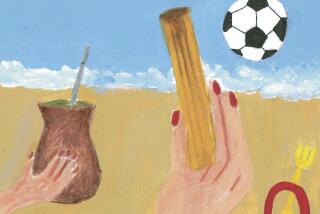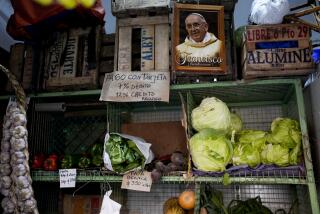All the right moves for Argentine economy
- Share via
BUENOS AIRES — Tango impresario Juan Fabbri can’t get a table at the 500-seat dinner theater he runs. That’s because Esquina Carlos Gardel in Buenos Aires is packed with tourists every night.
Fabbri’s clients pay $80 to $160 each to slice into steaks while watching a movie about the 19th century roots of tango, Argentina’s signature melancholy music and dance. After dinner, they view a dance show with orchestra.
The theater fills up every night of the year except for Christmas Eve, when it’s closed, Fabbri said. “If I want to dine in my own joint, I have to eat standing up.”
He and businesspeople like him are enjoying tango’s resurgent popularity in Argentina’s capital, on the back of a boom in tourism.
Tango is a $450-million-a-year industry and accounts for 10% of entertainment spending in Buenos Aires. Not bad for a century-old dance form competing with movies, video arcades, stadium rock and raves.
Theaters like Fabbri’s employ choreographers, dancers, musicians and costumers, all contributing to a so-called tango economy that is growing 25% a year.
Argentina has benefited from a sudden jump in tourism that followed the economic crisis of 2002. The nation’s currency, the peso, fell sharply during the crash, making travel to Argentina cheaper.
That led to a surge in demand for tango dinner theaters, which cater almost exclusively to visitors from Asia, Europe and the Americas.
“About 85% of foreign tourists go to a tango show because it combines two things they seek: seeing the tango and eating well,” said Marcelo Ruggieri, who heads a business chamber representing 13 tango dinner theaters. “The beef is key.”
Like a New Orleans jazz club or a samba night in Rio de Janeiro, a tango show is a must-see for visitors to Buenos Aires.
“If you don’t see this, you don’t see Buenos Aires,” said Greek tourist Michael Dimadis, 30, who watched a tango show with European friends at Michelangelo, a tango theater with an emphasis on Argentine wines. “It’d be like going to Greece and not eating tzatziki.”
The budget-minded backpacker crowd also contributes to the tango economy, heading to bars where the accordion strains of traditional tango are remixed with electronica dance music.
And hard-core tango enthusiasts -- 25,000 a year come for tango classes -- attend social dances known as milongas and drop money on tango-dancing shoes and outfits.
“The biggest income producer for the city of Buenos Aires is tourism, and within tourism the most important spice is tango,” said Fabbri, who opened Esquina Carlos Gardel (Carlos Gardel Corner), named after tango’s best-known singer, seven years ago.
Fabbri began dancing tango in the early 1990s, mingling with an underworld of tango dancing legends. He noticed tourists went to dance halls to soak up tango culture and sensed a business opportunity, first opening a dance hall of his own, then a cable television tango channel and now his theaters.
Some people in the dinner-show business fret that a glut is developing. But Fabbri says a surge in cruise ships docking in Buenos Aires will guarantee a full house at both Esquina Carlos Gardel and a new 1,200-seat establishment he and his partners are opening at a cost of more than $2 million.
Few locals shell out for tourist-oriented tango spectacles, but a new generation of Argentines has embraced the quintessentially national dance, attending a growing number of dance schools and milongas.
“In my generation -- we were young in the ‘70s -- we said no to tango, and Argentina had really good rock music. Nowadays the tango world is full of young, beautiful people. It’s good for everyone,” said Jorge Marchini, an economist who authored a government study on the tango business world.
“Every city has its flavor, its smells, its style, its way of life,” Marchini said, “and tango is the personality of Buenos Aires.”
More to Read
Sign up for The Wild
We’ll help you find the best places to hike, bike and run, as well as the perfect silent spots for meditation and yoga.
You may occasionally receive promotional content from the Los Angeles Times.






